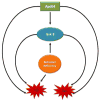Linking Abeta and tau in late-onset Alzheimer's disease: a dual pathway hypothesis
- PMID: 19038212
- PMCID: PMC2692134
- DOI: 10.1016/j.neuron.2008.11.007
Linking Abeta and tau in late-onset Alzheimer's disease: a dual pathway hypothesis
Abstract
Alzheimer's disease is characterized by abnormal elevation of Abeta peptide and abnormal hyperphosphorylation of the tau protein. The "amyloid hypothesis," which is based on molecular defects observed in autosomal-dominant early-onset Alzheimer's disease (EOAD), suggests a serial model of causality, whereby elevation of Abeta drives other disease features including tau hyperphosphorylation. Here, we review recent evidence from drug trials, genetic studies, and experimental work in animal models that suggests that an alternative model might exist in late-onset AD (LOAD), the complex and more common form of the disease. Specifically, we hypothesize a "dual pathway" model of causality, whereby Abeta and tau can be linked by separate mechanisms driven by a common upstream driver. This model may account for the results of recent drug trials and, if confirmed, may guide future drug development.
Figures



References
-
- Aisen PS. Tarenflurbil: a shot on goal. Lancet Neurol. 2008;7:468–469. - PubMed
-
- Aisen PS, Gauthier S, Vellas B, Briand R, Saumier D, Laurin J, Garceau D. Alzhemed: a potential treatment for Alzheimer’s disease. Curr Alzheimer Res. 2007;4:473–478. - PubMed
-
- Asuni AA, Hooper C, Reynolds CH, Lovestone S, Anderton BH, Killick R. GSK3alpha exhibits beta-catenin and tau directed kinase activities that are modulated by Wnt. Eur J Neurosci. 2006;24:3387–3392. - PubMed
-
- Bales KR, Dodart JC, DeMattos RB, Holtzman DM, Paul SM. Apolipoprotein E, amyloid, and Alzheimer disease. Mol Interv. 2002;2:363–375. 339. - PubMed
Publication types
MeSH terms
Substances
Grants and funding
LinkOut - more resources
Full Text Sources
Other Literature Sources
Medical

